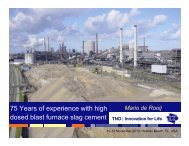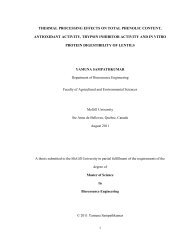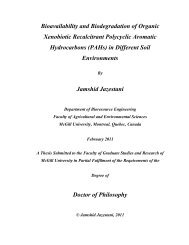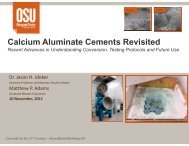foam-mat freeze drying of egg white and ... - McGill University
foam-mat freeze drying of egg white and ... - McGill University
foam-mat freeze drying of egg white and ... - McGill University
Create successful ePaper yourself
Turn your PDF publications into a flip-book with our unique Google optimized e-Paper software.
3.6.1.1 Freezing<br />
Freezing is one <strong>of</strong> the important steps if <strong>freeze</strong> <strong>drying</strong>. The freezing <strong>of</strong> the<br />
product can be achieved either within the <strong>freeze</strong> <strong>drying</strong> apparatus or in a separate<br />
freezing chamber <strong>and</strong> the choice mainly depends on the cost <strong>and</strong> operating methods used.<br />
Freezing has some important functions like, partial dehydration <strong>and</strong> increasing the<br />
rigidity <strong>of</strong> the structure. Freezing temperature should be much lesser than that <strong>of</strong> freezing<br />
temperature <strong>of</strong> pure water as water is mostly present in the combined form. The most<br />
common freezing temperature is – 30 °C. During freezing most <strong>of</strong> the free water is<br />
completely frozen <strong>and</strong> only bound water remains unfrozen. (Flink & Knudsen 1983;<br />
Liapis & Bruttini 1995).<br />
During freezing the rigidity <strong>of</strong> the <strong>mat</strong>erial increases due to ice for<strong>mat</strong>ion <strong>and</strong> this<br />
may not be uniform throughout the frozen <strong>mat</strong>erial. This is due to the presence <strong>of</strong> bound<br />
water, which remains unfrozen. These unfrozen regions are supported by the surrounding<br />
ice, which prevents defor<strong>mat</strong>ion <strong>of</strong> the product to some extent. The method <strong>of</strong> freezing<br />
(quick freezing or slow freezing) can play a major role in determining the structural<br />
integrity <strong>of</strong> the product during freezing (Mellor 1978; Flink & Knudsen 1983; Liapis &<br />
Bruttini 1995).<br />
3.6.1.2 Primary <strong>drying</strong> Stage<br />
During primary <strong>drying</strong>, the frozen water is removed by subli<strong>mat</strong>ion. To achieve<br />
<strong>drying</strong> during primary stage the pressure inside the <strong>drying</strong> chamber must be less than or<br />
in equilibrium with the vapour pressure <strong>of</strong> the frozen water. For pure water the absolute<br />
pressure should be 4.58 mm Hg or less at 0 °C (Figure 3.4). For practical <strong>drying</strong><br />
applications the temperature <strong>and</strong> pressure combination must be lower than that <strong>of</strong> pure<br />
23









